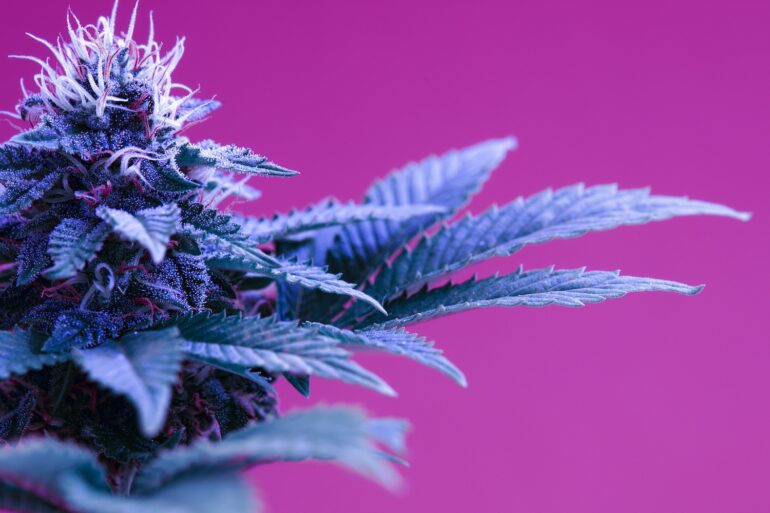Hexahydrocannabiphorol (HHCP) is a relatively new and unknown semisynthetic cannabinoid. It’s a hydrogenated form of THCP, and an intoxicating THC isomer.
The molecular structure of HHCP is similar to delta-9 THC, but with a seven-carbon chain instead of a five-carbon chain. The more links there are in this side chain, the better the cannabinoid interacts with your endocannabinoid system and binds to your brain’s CB1 receptors, making HHCP a very potent cannabinoid.
In the body, CB1 receptor activation induces several positive effects, including euphoria, relaxation, pain relief, sleep promotion, and overall health and wellness. CB2 receptor activation by THC-like compounds helps calm inflammation, protect neurons, and relieve pain.
However, it can also have some downsides, such as paranoia, anxiety, short-term memory loss, dizziness, GI upset, and nausea.
What Is HHCP?
HHCP is short for hexahydrocannabiphorol and is a highly intoxicating semisynthetic THC isomer and hydrogenated form of THCP.
Companies and their marketing teams claim HHCP is up to—or even more than—30 times stronger than delta-9 THC, boasting better bioavailability and longer-lasting effects.
Notably, there are no clinical studies yet on HHCP to accurately determine its effects and tolerability.
According to anecdotal evidence, HHCP products can “medicate” you for up to 12 hours (peak effects around 2-4 hours), and only a “very small” quantity is required. Beneficial HHCP effects include moderate-to-intense euphoria, relaxation, stress relief, physical sensations, and sleep promotion.
However, given the intense nature of HHCP, negative side effects such as paranoia, anxiety, fast heart rate, dry mouth and eyes, dizziness, and nausea can occur, even in smaller doses than delta-9 THC. This indicates that caution is needed even for experienced consumers.
Chemical Formula
HHCP has the chemical formula C23H36O2, translating to 23 carbon atoms, 36 hydrogen atoms, and two oxygen atoms.
There are two forms in existence, 9α-HHCP (S) and 9β-HHCP (R). Both can be found in commercial products, which carry some differences, unknown effects, and potential psychiatric risks.
Similarly, HHC also has R and S forms. Both HHC stereoisomers are present and available in hemp products because of the natural carbon asymmetry. The tricky thing is, that there is some evidence to show that the R version has more affinity for CB receptors.
Beyond this, we don’t know the physiological differences between them and how much of each form or other compounds may be present in unregulated, semisynthetic hemp products.
By comparison, delta-9 THC has the chemical formula C21H30O2 (21 carbon atoms, 30 hydrogen atoms, and two oxygen atoms).
HHCP’s two extra carbon atoms on its molecular structure predictably allow better cannabinoid 1 (CB1) receptor binding, causing a stronger, more intense euphoric high.
Hydrogenation
As mentioned, HHCP is a hydrogenated form of THCP. Hydrogenation, in this instance, refers to a chemical reaction between THCP, molecular hydrogen, and a catalyst such as nickel and platinum.
This reaction breaks the double bond in THCP’s structure, causing molecular instability. Adding hydrogen stabilizes the molecule, gives it higher heat and UV light resistance, and extends its shelf-life by up to a year more than delta-9 THC.
For commercial purposes, HHCP is similar to HHC. In the U.S., the hydrogenation process starts with legal, hemp-based CBD extract. A series of harsh reactions eventually turn CBD into delta-8 or delta-9 THCP, and final hydrogenation yields HHCP in R and S forms.
Lack of Scientific Evidence
Research on HHCP is practically non-existent. There are no direct studies on how it interacts with animals or your body, or how it could help you with certain health and wellness issues.
However, we can safely assume that future HHCP research will discover physiological and pharmacological mechanisms similar to delta-9 and THCP due to their almost identical molecular structures.
For example, delta-9 and THCP interact with your endocannabinoid system, a unique biological network comprising cannabinoid receptors, endogenous compounds (endocannabinoids), and enzymes. This network regulates and maintains core physiological functionality, including mood, sleep, stress response, appetite, and memory.
Delta-9 and THCP activate cannabinoid 1 (CB1) and cannabinoid 2 (CB2) receptors.
CB1 receptors are present in your brain and central and peripheral nervous systems. Activation essentially boosts your endocannabinoid system, mimicking increased natural endocannabinoid levels, and keeps it activated, which is why HHCP and other THC isomers are important cannabinoids.
The Benefits Are Purely Speculative
Since HHCP is relatively new and understudied, we can’t conclusively say what HHCP products are good for. Its health and wellness benefits are purely speculative.
However, since HHCP is a THC homolog and a hydrogenated version of THCP with a similar molecular structure to both, we can safely assume they all share similar benefits with a degree of potency leaning towards THCP.
We know through preclinical animal research that THCP is a pain reliever, intoxicant, and sedative, and causes catalepsy symptoms in mice.
Catalepsy is a nervous system dysfunction that causes muscle rigidity and immobility, sometimes caused by Parkinson’s disease, medications, epilepsy, schizophrenia, and illicit substance withdrawal. This means THCP and HHCP could be expected to cause “the weed shakes” more than other, less potent cannabinoids.
HHCP and THCP likely have similar benefits to delta-9 THC via CB1 receptor binding, though there’s very little scientific evidence to back this theory up or provide specific dosing suggestions.
The potential benefits of delta-9 THC include:
- Anti-anxiety and antidepressant
- Pain relief and anti-inflammatory
- Anti-glaucoma and ocular eye pressure relief
- Anti-proliferation
- Neuroprotection and symptomatic relief of neuropsychiatric disorders
- Alleviate nausea and vomiting
- Increased appetite
- Focus and concentration (for ADD and ADHD)
- General health and wellness (with CBD, CBG, CBC, and other related non-intoxicating cannabinoids)
How Potent Are the Effects of HHCP?
HHCP makes you incredibly high with feelings of intense euphoria, focus, sedation, mental stimulation, and physical sensations, depending on the dose and individual.
Product quality also matters. Several anecdotal claims online try to guess its relative intensity, but there is no human research to confirm relative psychotropic effects.
Research shows alkyl side chain length directly correlates with the intensity of a high and that three carbon atoms are required for CB1 binding (five to eight is optimal). HHCP has a seven-link carbon chain, while HHC and delta-9 have a five-link carbon chain, meaning HHCP is better at binding to CB1 receptors. Delta-9 is a partial agonist with weaker binding affinity, resulting in a less potent but still noticeable euphoric high.
HHCP vs. CBD: Key Differences
- CBD is a totally different cannabinoid from HHCP. It’s non-intoxicating and doesn’t induce a euphoric high in any quantity. However, like HHCP, CBD does influence brain activity meaning it’s still a psychoactive substance, just non-intoxicating.
- CBD doesn’t activate CB1 receptors as an agonist but acts as a negative allosteric modulator. CBD’s negative allosteric modulatory behavior inhibits THC’s agonist activity, partially stopping it from binding to CB1 receptors, thus reducing or preventing it from inducing a euphoric high.
- CBD also interacts with other receptor sites, including serotonin (for anxiety relief) and the TRP family (for itching and pain relief). It’s unclear whether HHCP interacts with these receptors.
HHCP vs. HHCO: Key Differences
- HHCP and HHC-O acetate are similar THC isomers with almost identical molecular structures. However, HHCP is hydrogenated THCP (7-carbon chain), and HHCO is acetylated HHC (separate acetate group, but still has a 5-carbon chain).
- Producers create HHCO by combining HHC molecules with acetate anhydride, which adds the “-O” group to its name. Manufacturers claim HHCO is 1.5 times stronger than HHC, though there’s no scientific evidence backing this claim up.
References
- Cayman Chem. (2023). 9(R)-Hexahydrocannabiphorol. Retrieved November 3, 2023, from https://www.caymanchem.com/product/36346/9(r)-hexahydrocannabiphorol
- Cayman Chem. (2023). 9(S)-Hexahydrocannabiphorol. (n.d.-b). Retrieved November 3, 2023, from https://www.caymanchem.com/product/36347
- Cayman Chem. (2023). Δ9-THC. Retrieved November 3, 2023, from https://www.caymanchem.com/product/12068
- Bow, E. W., & Rimoldi, J. M. (2016). The Structure–Function Relationships of Classical Cannabinoids: CB1/CB2 Modulation. Perspectives in Medicinal Chemistry, 8, 17–39. https://doi.org/10.4137/PMC.S32171
- Casati, S., Rota, P., Bergamaschi, R. F., Palmisano, E., La Rocca, P., Ravelli, A., Angeli, I., Minoli, M., Roda, G., & Orioli, M. (2022). Hexahydrocannabinol on the Light Cannabis Market: The Latest “New” Entry. Cannabis and Cannabinoid Research. https://doi.org/10.1089/can.2022.0253
- Citti, C., Linciano, P., Russo, F., Luongo, L., Iannotta, M., Maione, S., Laganà, A., Capriotti, A. L., Forni, F., Vandelli, M. A., Gigli, G., & Cannazza, G. (2019). A novel phytocannabinoid isolated from Cannabis sativa L. with an in vivo cannabimimetic activity higher than Δ9-tetrahydrocannabinol: Δ9-Tetrahydrocannabiphorol. Scientific Reports, 9(1), Article 1. https://doi.org/10.1038/s41598-019-56785-1
- Ebbert, J. O., Scharf, E. L., & Hurt, R. T. (2018). Medical Cannabis. Mayo Clinic Proceedings, 93(12), 1842–1847. https://doi.org/10.1016/j.mayocp.2018.09.005
- Höfert, L., Becker, S., Dreßler, J., & Baumann, S. (2023). Quantification of (9R)- and (9S)-hexahydrocannabinol (HHC) via GC–MS in serum/plasma samples from drivers suspected of cannabis consumption and immunological detection of HHC and related substances in serum, urine, and saliva. Drug Testing and Analysis, n/a(n/a). https://doi.org/10.1002/dta.3570
- Mansell, H., Quinn, D., Kelly, L. E., & Alcorn, J. (2022). Cannabis for the Treatment of Attention Deficit Hyperactivity Disorder: A Report of 3 Cases. Medical Cannabis and Cannabinoids, 5(1), 1–6. https://doi.org/10.1159/000521370
- National Academies of Sciences, E., Division, H. and M., Practice, B. on P. H. and P. H., & Agenda, C. on the H. E. of M. A. E. R. and R. (2017). Therapeutic Effects of Cannabis and Cannabinoids. In The Health Effects of Cannabis and Cannabinoids: The Current State of Evidence and Recommendations for Research. National Academies Press (US). https://www.ncbi.nlm.nih.gov/books/NBK425767/
- PubChem. (2023). Hexahydrocannabinol. Retrieved November 3, 2023, from https://pubchem.ncbi.nlm.nih.gov/compound/522237
- Tanaka, R., & Kikura-Hanajiri, R. (2023). Identification of hexahydrocannabinol (HHC), dihydro-iso-tetrahydrocannabinol (dihydro-iso-THC) and hexahydrocannabiphorol (HHCP) in electronic cigarette cartridge products. Forensic Toxicology. https://doi.org/10.1007/s11419-023-00667-9

